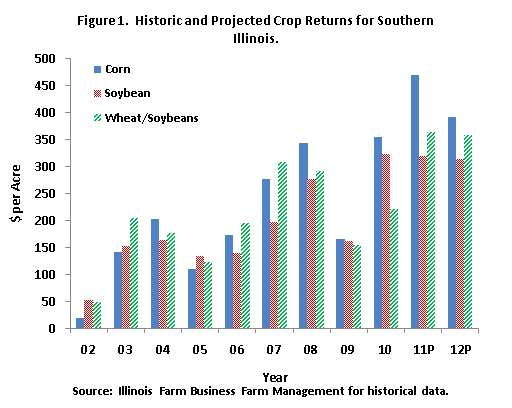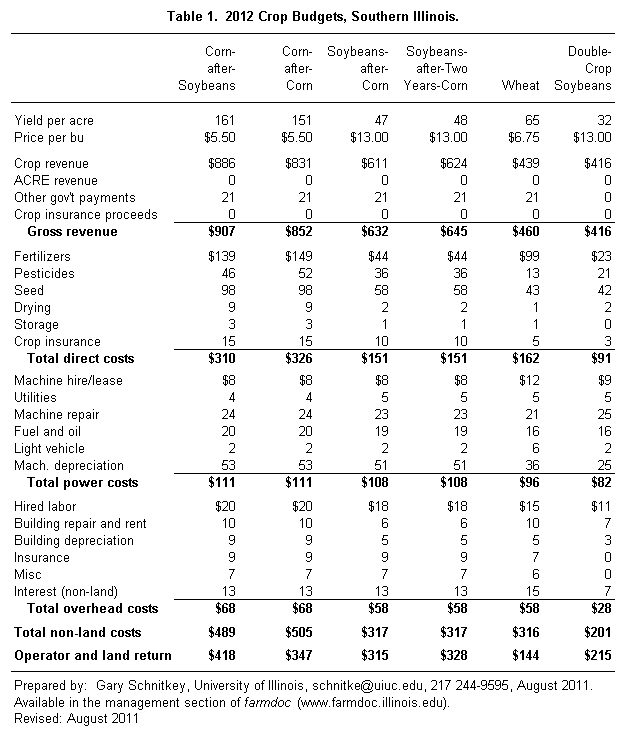Wheat/Double-Crop Soybeans Competitive in Southern Illinois for 2012
Recently compiled 2012 southern Illinois crop budgets have projected operator and farmland returns for wheat/double crop soybean at $359 per acre. This $359 per acre return compares to $418 per acre from corn-after-soybeans and $315 per acre for soybeans. In 2012 budgets, corn is projected more profitable than wheat/double-crop soybeans. Wheat/double-crop soybeans are projected more profitable than soybeans.
The projected 2012 profit ordering is similar to the historical, average ordering. From 2002 through 2010, corn was more profitable than wheat/double-crop soybeans by $17 per acre. Wheat/double crop soybeans were $17 more profitable than soybeans (see Figure 1). Being close to the historical average suggests that farmers have economic incentives similar to previous years for planting wheat, further suggesting that farmers likely plant wheat acres close to historical norms, weather permitting.
Relative profitability of crops varies across years. In the ten years from 2002 through 2011, corn was the most profitable crop in 5 out of 10 years, soybeans in 2 out of 10 years, and wheat/double-crop soybeans in 3 out of 10 years (see Figure 1). This variability suggests that planting multiple crops is a good risk management practice in southern Illinois.

Budgets used in arriving at crop returns are shown in Table 1. Points from these budgets are:
- Prices used in making projections are $5.50 per bushel for corn, $13.00 per bushel for soybeans, and $6.75 per bushel for wheat. All prices are above historical averages.
- Yields are based on historical yields, stated in terms of 2012 yields considering yield increases.
- The $359 operator and farmland return for wheat/double-crop soybeans is composed of a $144 return for wheat and a $215 return for double-crop soybeans. In 2012, projected return for wheat alone does not exceed the return for either corn or soybeans. In all years from 2002 through 2010, the average return for wheat did not exceed the return for either corn or soybeans. For wheat to be competitive with either corn or soybeans from a return standpoint, a double-crop soybean crop must follow the wheat crop. Somewhat paradoxically, a high soybean price aids in making wheat/double crop soybeans a profitable alternative.
- Corn-after-soybean return of $418 per acre exceeds the wheat/double-crop soybean crop returns of $359 per acre. However, corn-after-corn returns of $347 per acre are less than the wheat/double-crop soybean return of $359 per acre. Growing more corn that requires corn to follow corn is not projected to have as high of returns as wheat/double-crop soybeans.

Summary
Wheat/double-crop soybeans have competitive returns with corn and soybeans. Hence, southern Illinois farmers likely will devote usual acres to wheat if weather permits planting.
Crop budgets for other regions are available in the management section of farmdoc here. The direct link to the budgets is here.
Disclaimer: We request all readers, electronic media and others follow our citation guidelines when re-posting articles from farmdoc daily. Guidelines are available here. The farmdoc daily website falls under University of Illinois copyright and intellectual property rights. For a detailed statement, please see the University of Illinois Copyright Information and Policies here.







